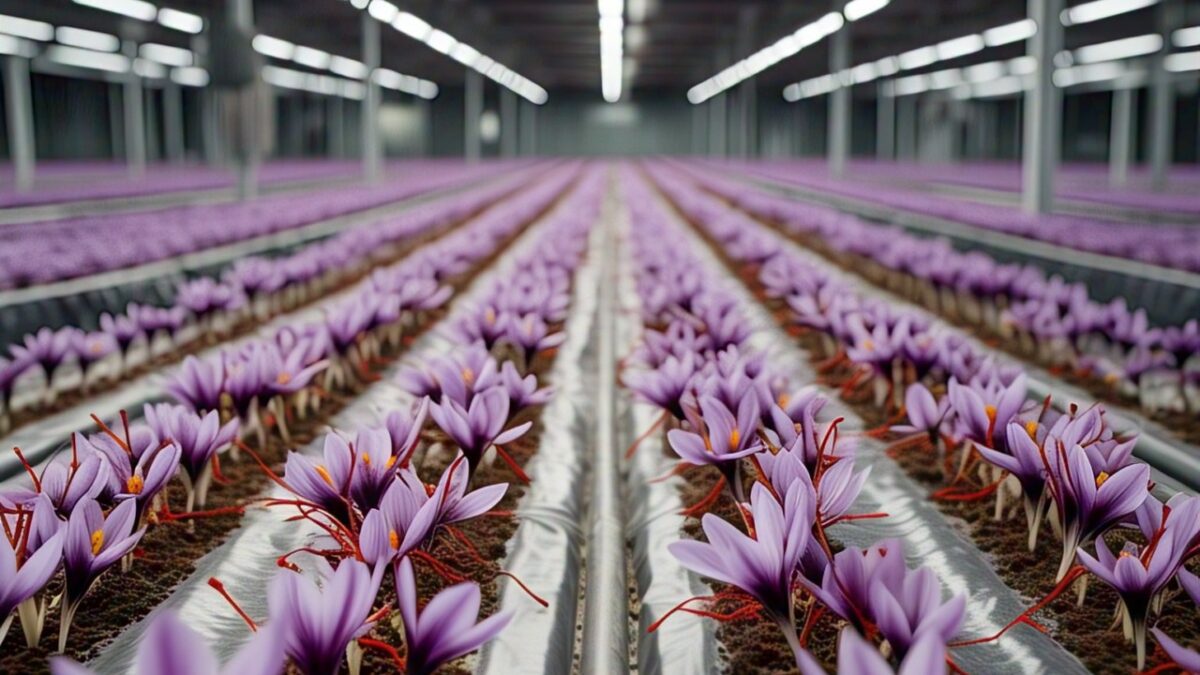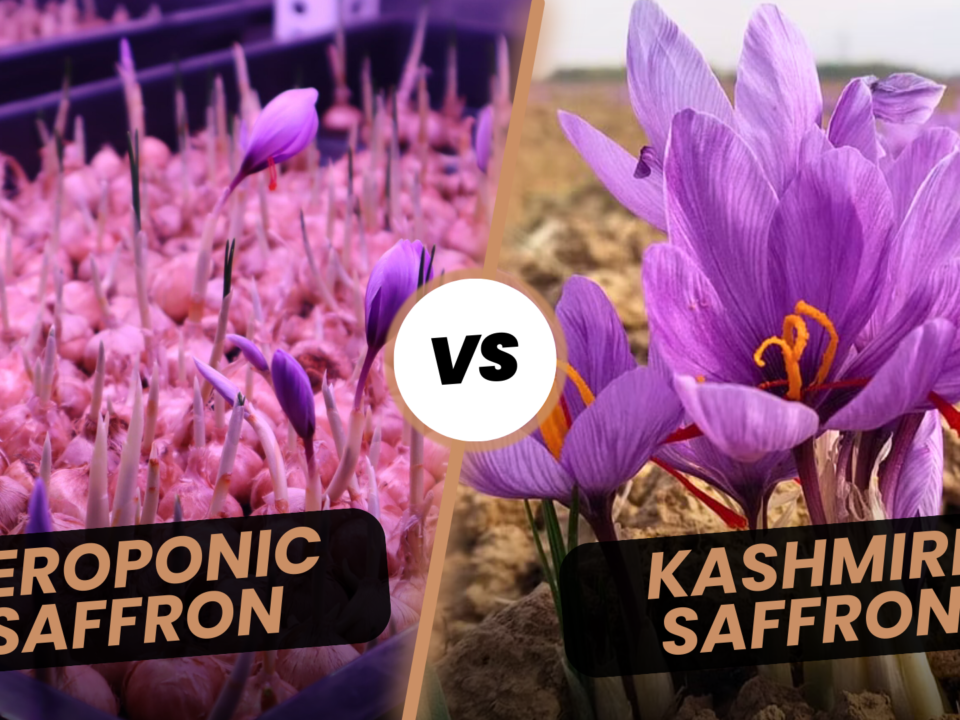Aeroponic Saffron Farming: Revolutionizing Urban Agriculture in India
Saffron, known as “red gold,” is one of the world’s most valuable spices. Traditionally grown in the cool climates of Kashmir, saffron cultivation is now being revolutionized by
aeroponic farming. This innovative method allows farmers to grow saffron
year-round, achieve
300% higher yields and use
90% less water compared to traditional methods. In this article, we’ll explore how aeroponic saffron farming works, its benefits and its integration with smart city initiatives in India.
What is Aeroponic Saffron Farming?
Aeroponic farming is a soilless cultivation technique where plants are grown in an air or mist environment. The roots are suspended and nourished with a nutrient-rich mist, allowing for precise control over growing conditions. For saffron, this method is a game-changer, enabling cultivation in urban areas and regions with unsuitable climates.Unlike traditional farming, which relies on soil and natural weather conditions, aeroponic systems use technology to create the perfect environment for saffron growth. This includes controlling temperature, humidity, light and nutrient delivery. The result is a highly efficient and sustainable farming method that produces superior yields.
Why Choose Aeroponic Saffron Farming?
Aeroponic saffron farming offers numerous advantages over traditional methods, making it an attractive option for modern farmers. Here are the key benefits:
- 300% Higher Yield: Aeroponic systems produce up to three times more saffron compared to traditional methods. This is due to the optimized growing conditions and efficient nutrient delivery.
- Year-Round Cultivation: Controlled environments allow saffron to grow regardless of seasonal limitations. This means farmers can harvest saffron multiple times a year, increasing profitability.
- Water Efficiency: Aeroponic farming uses 90% less water than traditional methods, making it ideal for water-scarce regions. The closed-loop system recycles water, minimizing waste.
- Space-Saving: Vertical farming maximizes space, perfect for urban settings. Aeroponic systems can be stacked vertically, allowing farmers to grow more saffron in a smaller area.
- Pest-Free: Indoor systems reduce the risk of pests and diseases, eliminating the need for harmful pesticides. This results in cleaner, healthier saffron.
- Consistent Quality: Controlled environments ensure uniform growing conditions, producing saffron with consistent color, aroma and flavor.
How Aeroponic Saffron Farming Works
Aeroponic saffron farming involves growing saffron bulbs (corms) in a controlled environment without soil. Here’s a step-by-step breakdown of how it works:
- Root Suspension: Saffron roots are suspended in air and misted with a nutrient solution. This allows for maximum oxygen exposure, promoting faster growth.
- Climate Control: Temperature, humidity and light are optimized to mimic Kashmir’s natural conditions. This ensures the saffron corms receive the ideal environment for growth.
- Vertical Farming: Systems are stacked vertically to save space and increase yield. This is particularly beneficial for urban areas with limited land.
- Automation: IoT sensors and AI monitor and adjust conditions for optimal growth. Farmers can remotely control the system, ensuring consistent results.
- Harvesting: Saffron flowers are handpicked and the stigmas are carefully separated. This labor-intensive process ensures the highest quality saffron.
Integrating Aeroponic Saffron Farming with Smart City Initiatives
As Indian cities like Lucknow evolve into smart cities, aeroponic saffron farming aligns perfectly with their goals of sustainability and innovation. Here’s how this integration can work:
- Energy Efficiency: Smart grid systems can optimize power usage in aeroponic farms, reducing energy consumption and costs.
- Waste Management: Integrated systems can recycle and reuse water and nutrients efficiently, minimizing waste and environmental impact.
- Data Integration: Farm data can be incorporated into city-wide information systems for better resource management and decision-making.
- Urban Planning: Vertical saffron farms can be seamlessly integrated into smart building designs, making agriculture a part of urban infrastructure.
By embracing aeroponic saffron cultivation, cities like Lucknow are positioning themselves at the forefront of sustainable urban development.
The Impact on Traditional Saffron Farmers
While urban aeroponic saffron cultivation brings numerous benefits, it’s important to consider its impact on traditional saffron farmers, particularly in regions like Kashmir. Here’s how we envision a balanced approach:
- Knowledge Sharing: Traditional farmers can be trained in aeroponic techniques, expanding their skill set and income opportunities.
- Market Diversification: Urban-grown saffron can complement, rather than replace, traditional saffron in the market, creating a diverse product range.
- Quality Improvements: Techniques learned from aeroponic farming can be applied to improve traditional farming methods, enhancing overall saffron quality.
- Cooperative Models: Partnerships between urban and traditional farmers can create a more robust saffron industry, benefiting all stakeholders.
Consumer Perspective: Acceptance of Aeroponic Saffron
As we introduce aeroponic-grown saffron to the market, consumer acceptance is crucial. Here’s how we’re addressing this:
- Education Campaigns: Informing consumers about the benefits of aeroponic cultivation through workshops, social media and packaging.
- Transparency: Providing clear information about growing methods and quality control processes to build trust.
- Taste Tests: Organizing blind taste tests to demonstrate the quality of aeroponic saffron and its similarity to traditional saffron.
- Sustainability Messaging: Highlighting the eco-friendly aspects of urban saffron farming to appeal to environmentally conscious consumers.
Regulatory Considerations for Urban Saffron Farming
As we pioneer aeroponic saffron cultivation in India, navigating the regulatory landscape is crucial. Key considerations include:
- Food Safety Standards: Ensuring compliance with food safety regulations for urban-grown crops.
- Zoning Laws: Working with local authorities to integrate urban farms into city planning and zoning regulations.
- Quality Certification: Developing standards for aeroponic-grown saffron to ensure market acceptance and consumer trust.
- Environmental Impact Assessments: Conducting studies to demonstrate the sustainability of urban saffron farming and its benefits.
Conclusion: A New Era for Saffron Cultivation
The revolution in saffron cultivation happening in India represents more than just a new way of growing a valuable spice. It symbolizes the potential of innovative thinking and technology to transform agriculture, particularly in urban settings. By embracing aeroponic techniques and vertical farming for saffron, we’re not only bringing this precious crop to new geographical areas but also addressing crucial issues of sustainability, food security and urban development.As we continue to refine and expand these methods, the future of saffron cultivation looks brighter than ever. From the cooler, controlled environments of our indoor farms to the bustling markets of Lucknow and beyond, this innovative approach to saffron growing is set to change the spice industry forever. It’s a testament to human ingenuity and a beacon of hope for sustainable urban agriculture worldwide.
Explore the potential of aeroponic saffron farming today. Visit buykashmirisaffron.com to learn more and get started!FAQs About Aeroponic Saffron Farming
1. Can saffron really be grown outside of its traditional regions?
Yes, through aeroponic techniques and controlled environment agriculture, saffron can now be successfully cultivated in non-traditional areas like Lucknow.
2. How does the quality of aeroponic saffron compare to traditionally grown saffron?
Aeroponic saffron can match or even exceed the quality of traditionally grown saffron due to precise control over growing conditions.
3. Is aeroponic saffron cultivation more expensive than traditional methods?
While initial setup costs can be higher, aeroponic cultivation often leads to higher yields and year-round production, potentially making it more cost-effective in the long run.
4. How does aeroponic saffron farming impact water usage?
Aeroponic systems use up to 95% less water compared to traditional farming methods, making them highly water-efficient.
5. Can small-scale farmers adopt aeroponic saffron cultivation?
Yes, aeroponic systems can be scaled to suit various operation sizes, making them accessible to small-scale farmers with the right training and investment.
5. Can Aeroponic Saffron farming replace Kashmir’s Natural Saffron?
No, While aeroponic farming produces high-quality saffron, it cannot fully replicate the unique aroma and flavor of naturally grown Kashmiri saffron. Kashmir’s climate, soil and altitude create the perfect conditions for saffron, resulting in the world’s best quality. The cold winters, moderate rainfall and well-drained soil of Kashmir’s Pampore region are unmatched by any artificial system.However, aeroponic farming is an excellent alternative for regions where traditional cultivation is not feasible. It allows farmers to grow saffron in urban areas and regions with unsuitable climates, bringing this precious spice to new markets.







